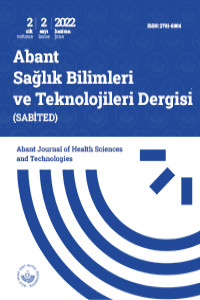İleri Derecede Posterior Mandibular Atrofili Hastalarda Konservatif Implant Cerrahisine Alternatif Konforlu Bir Implant Yerlestirme Teknigi: Bukkale eğimli implant yerlestirme
Abstract
Posterior mandibula bölgesi kısmen veya tamamen atrofik hastalarının rehabilitasyonu icin yanağa doğru eğimli yerleştirilmiş implant ile kombine standard abutment yerleştirilmesi operasyonu yapıldı. Inferior alveoler sinirin lokalizasyonu ve implantın pozisyonu, implantasyonun eğim derecesi, horizontal ve vertikal mesafeler vb. gibi değerlendirmeler sinire zarar vermemek adına önceden yapıldı. Bilgisayarli tomografik görüntülerin analizinden sonra, implantlar orta krestalden 3 mm bukkale dogru yatırılarak yerleştirildi. Bu şekilde altı hastaya implantları uygulandı ve bir yıllık takip süresinde değerlendirildi. Bukkal mesafe alt molar bölgede mandibular kanal seviyesinde lingual mesafeden daha yüksekti. Mandibular molar bölgede ortalama dikey kazanç mesafesi 4.92 mm idi. Implant yerlestirme simülasyonu öncesi ilk değerlendirmede mandibular kanal üzerindeki dikey yiikseklik yaklaşık olarak 7.25 mm iken, elde edilen implant uzunluğu 10.25 mm'ye kadar çıkarıldı. İmplantların eğim derecesi ise ortalama 22°ydi. Klinik vakalar bu metodolojinin cerrahi fizibilitesini doğruladı. İmplantların bukkale eğimli şekilde yatırılarak yerleştirilmesi yöntemiyle, herhangi başka bir cerrahi prosedür gerekmeksizin atrofik posterior mandibula hastalarında daha uzun, dolayısıyla da stabil implantların yer leştirilmesini sağlayabiliriz.
References
- 1. Misch CE. Contemporary Implant Dentistry. 3rd ed., St. Louis.: Mosby Publications; 2007.
- 2. Greenstein G, Tarnow D. the mental foremen and nerve: Clinical and anatomical factors related to dental implant placement. A literature review. J Periodontol 2006;77: 1933-43.
- 3. Spear F. The challenges of presenting interdisciplinary treatment. Advanced Esthetics lnterdiscip Dent 2005; I: 2
- 4. Hsu ML, Chen FC, Cheng CK. 1nfluence of off axis loading of an anterior maxillae y implant: A 3-dimensional finite element analysis. Int J Oral Maxillofac 1mplants 2007;22: 301 -9.
- 5. Kraut RA. Interactive radiologic diagnosis and case planning for implants. Dent Implantol Update l994; 5:49-55.
- 6. Kola MZ, Shah AH, Khalil H, Rabah AM, Harby NMH, Sabra SA, Raghav D. Surgical Templates for Dental Implant Positioning; Current Knowledge and Clinical Perspectives. Nigerian Journal of Surgery 2015 ;2 I: I -5.
- 7. Pancko F, Dyer I, Weisglass S, Kraut RA. Use of Tilted Implants in Treatment of the Atrophic Posterior Mandible: A Preliminary Report of a Novel Approach. J Oral Maxillofac Surg 20 l0; 68:407- 13.
- 8. Reiskin AB. Implant imaging status, controversies and new developments. Dent Clin North Am 1 998; 42:47-56.
- 9. Scarano A, Carinci F, Assenza B, Piattelli M, Murmura G, Piattelli A. Vertical ridge augmentation of atrophic posterior mandible using an inlay technique with a xenograft without miniscrews and miniplates: case series. Clin Oral Impl Res 2011 ;22: 1125-30.
Buccally Tilted and Placed Implant: an Applicable Implant Insertion Technique Alternative to Conservative Implant Surgery for Patients with Extremely Atrophic Mandible
Abstract
A standard abutment placement operation combined with an implant placed towards the cheek for the rehabilitation of patients whose posterior mandible region is partially or completely atrophic. The localization of the inferior alveolar nerve and the position of the implant, the inclination degree of the implantation, horizontal and vertical distances and similar evaluations were done beforehand in order not to damage the nerve. Subsequent to the analysis of computerized tomographic images, buccally placed and tilted implants were inserted for each patient placed 3mm buccally away from the midcrest. Implant operations were performed on 6 patients and there was a one year follow-up period. The buccal distance was higher at the level of the mandibular canal in the lower molar region than the lingual distance. The average vertical gain distance in the mandibular molar regions was 4.92 mm. While the average vertical height on the mandibular canal was 7.25 mm in the initial evaluation, before implant placement simulation, the obtained implant length was increased to 10.25 mm on average. The average inclination degree of the implants was 22°. Clinical cases certified the surgical feasibility of this methodology. With the method of placing the implants by tilting them into the buccal, we can provide the placement of longer implants especially in extreme atrophic posterior mandible cases without the need for any other surgical procedure.
References
- 1. Misch CE. Contemporary Implant Dentistry. 3rd ed., St. Louis.: Mosby Publications; 2007.
- 2. Greenstein G, Tarnow D. the mental foremen and nerve: Clinical and anatomical factors related to dental implant placement. A literature review. J Periodontol 2006;77: 1933-43.
- 3. Spear F. The challenges of presenting interdisciplinary treatment. Advanced Esthetics lnterdiscip Dent 2005; I: 2
- 4. Hsu ML, Chen FC, Cheng CK. 1nfluence of off axis loading of an anterior maxillae y implant: A 3-dimensional finite element analysis. Int J Oral Maxillofac 1mplants 2007;22: 301 -9.
- 5. Kraut RA. Interactive radiologic diagnosis and case planning for implants. Dent Implantol Update l994; 5:49-55.
- 6. Kola MZ, Shah AH, Khalil H, Rabah AM, Harby NMH, Sabra SA, Raghav D. Surgical Templates for Dental Implant Positioning; Current Knowledge and Clinical Perspectives. Nigerian Journal of Surgery 2015 ;2 I: I -5.
- 7. Pancko F, Dyer I, Weisglass S, Kraut RA. Use of Tilted Implants in Treatment of the Atrophic Posterior Mandible: A Preliminary Report of a Novel Approach. J Oral Maxillofac Surg 20 l0; 68:407- 13.
- 8. Reiskin AB. Implant imaging status, controversies and new developments. Dent Clin North Am 1 998; 42:47-56.
- 9. Scarano A, Carinci F, Assenza B, Piattelli M, Murmura G, Piattelli A. Vertical ridge augmentation of atrophic posterior mandible using an inlay technique with a xenograft without miniscrews and miniplates: case series. Clin Oral Impl Res 2011 ;22: 1125-30.
Details
| Primary Language | English |
|---|---|
| Subjects | Health Care Administration |
| Journal Section | Case Reports |
| Authors | |
| Publication Date | December 21, 2022 |
| Published in Issue | Year 2022 Volume: 2 Issue: 2 |

